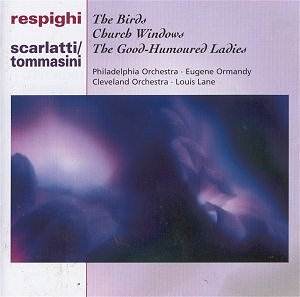Respighi paints in light, delight, birdsong, Handelian
flourishes and Vivaldian zest. The thematic material is looted from
Rameau's music for keyboard. The Prelude and La Gallina (Hen)
are grand (as is the end of the Cuckoo movement) but Respighi's
most gentle vein is released for the La colomba (dove) and L'usignuolo
(Nightingale). La Gallina ends with a regal long-lofted trumpet
line the playing of which reminds me of another Ormandy Philadelphia
triumph: the suite from The Golden Cockerel. Respighi venerated
Rimsky. That much is also clear from a much more indulgently saturated
canvas. The four Church Windows are arranged and orchestrated
from a series of solo piano works based on Gregorian chant (a similar
impetus gave rise to his violin concerto - the equable Concerto Gregoriano).
The first movement Flight Into Egypt overflows with ideas and
influences from Rimsky, to Janáček
(Taras Bulba), to Finzi (in anticipation this time). The
screeching and dive-bombing rushing of the opening few minutes of St
Michael Archangel is suggestive of Vaughan Williams' Fourth Symphony
and gives way to one of those themes later appropriated by Hollywood
for wide river (Rio Grande or Shenandoah) westerns. The
Matins of St Clare are placid and set the scene for St Gregory
the Great. For me this has always evoked the groaning putting to
sea of a giant quinquireme. The oars touch the water languidly and gradually
build momentum as the vessel slips into the main passage and makes for
deep water. It is in this movement that the mark left on Howard Hanson
by Respighi's teaching can best be felt (3.34 tr. 9). Respighi also
squirrelled away Rosenkavalier effects for use here (5.20 tr
9). This suite must surely have played its part in inspiring the film
music of Miklós Rózsa in 'Biblical' epics such as Ben
Hur. The organ registers with particular force in the St Gregory
movement.
The most consciously antiquarian approach is to be
found in Tommasini's orchestration of movements from the hundreds
of micro-sonatas Domenico Scarlatti wrote for the Queen of Spain. There
are three lively movements before we get to an andante of considerable
composure and then a gentle Non presto before the Cat's Fugue
and Finale. Unusually there is a harpsichord part for this suite. The
soloist is not named. Louis Lane and the Clevelanders are as brilliant
as the music demands.
Jackson Braider's notes do not give dates for these
pieces. There are French and German translations although the French
one is incomplete.
Rob Barnett


